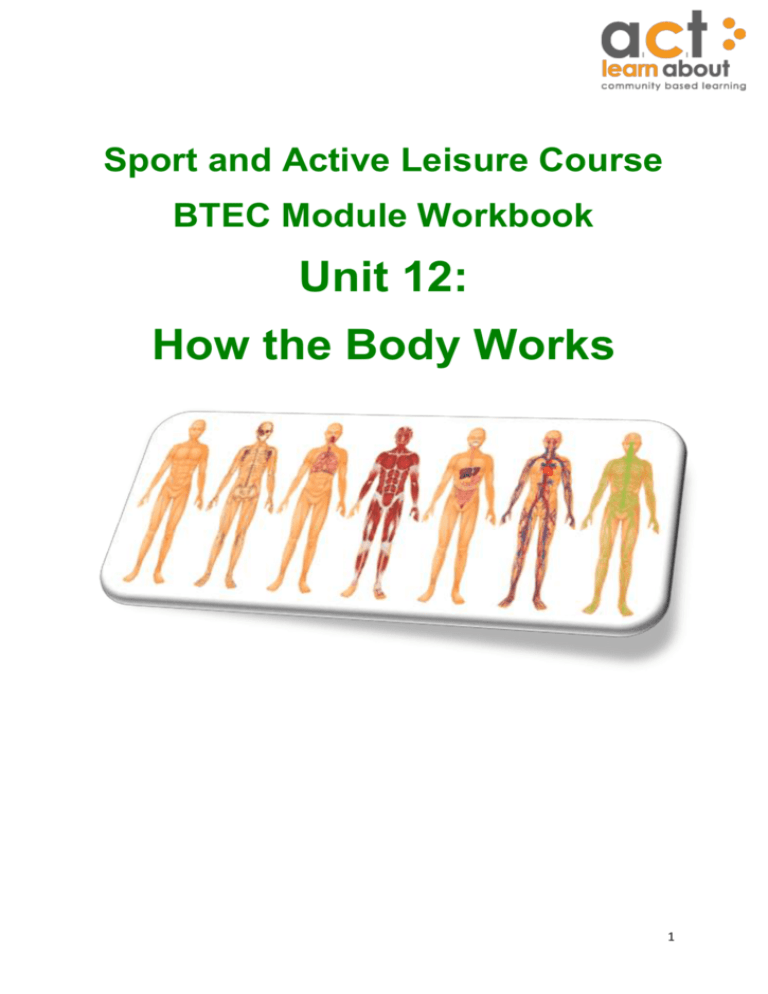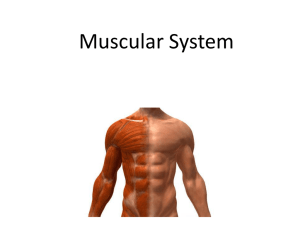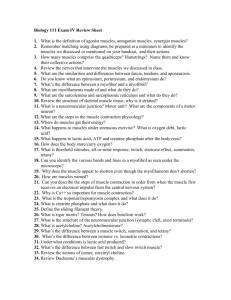How the Body Works How the Body Works Unit 12
advertisement

Sport and Active Leisure Course BTEC Module Workbook Unit 12: How the Body Works 1 How the Body Works Unit 12 - Assignment Brief Course: Edexcel BTEC Sport and Active Leisure level 1 Award, Certificate & Diploma Unit Title: Unit 12 How the Body Works QCF Level 1 – T/501/7249 (40hrs) Assignment title How the Body Works Learner Name Job Choice Instructor Name Evidence can • Individual learning plan, training agreement include: • Action plan • Evidence worksheets/fitness programmes/workbook • Assessor/witness observation • Audio or video recordings • Any other evidence which demonstrates competence Recording of Fitness assessments Personal, Candidates undertaking this unit will demonstrate PLTS in the Learning & following areas: • Reflective learners Thinking Skills participants. • Creative thinkers. • Team Workers. • Self-managers. • Effective (PLTS) Jargon Buster Issue Date: ALP-This stands for Assessing ELP-This stands for Extending Learners Progress, against the Learners Progress, above and BTEC criteria. beyond the BTEC criteria. Assessment Due Date: 2 By completing this BTEC unit: Y.S.B.A.T-You Should Be Able To Learning Outcome Assessment Criteria 1/ Know the functions of the skeletal 1.1 Identify the functions of the skeleton and muscular systems 1.2 Identify the functions of the muscular system 2/ Know the functions of the cardio 2.1 Identify the structure and function of respiratory systems the heart 2.2 Identify the structure and function of the lungs 3/ Know the requirements of a healthy 3.1 Identify the different nutrients needed diet for a healthy diet 3.1 Identify functions of each nutrient Scenario When a person takes part in sport and active leisure, their body has to react appropriately in order to supply the energy needed for running and jumping etc. It is important therefore that any sports participant understands the main body systems that are involved with this supply of energy. The skeletal system, the muscular system, the cardiovascular system and the respiratory system are all explored in this unit. Learners will gain an understanding of the basic function of each system. They will also learn some of the major bones and major muscles of the body. Knowledge of this anatomical terminology is required for any person who wants to work in the sport and active leisure industry. All of these body systems require good nutrition in order to function properly and this unit also explores the basic requirements of a healthy diet. From this information, the learner will be able to know which foods to choose to eat for a healthy diet. 3 Aim The aim of this unit is to prepare the learner so that they understand the main body systems that are involved with the supply of energy. Incentive When a person takes part in sport and active leisure, their body has to react appropriately in order to supply the energy needed for physical exercise. It is important therefore that any sports participant understands the main body systems that are involved with this supply of energy. This will help learners to understand why and how they should prepare themselves for sports participation. Reason Why According to the World Health Organization, health is a state of complete physical, mental and social wellbeing; not merely the absence of disease or infirmity (WHO, 1946) Physical activity is defined as any bodily movement produced by skeletal muscles that require energy expenditure. Physical inactivity is an independent risk factor for chronic disease and is estimated to cause 1.9 million deaths globally 4 The Skeleton ALP 1.1 Task 1 Functions of the skeleton You need to understand the functions of the skeleton. These are: ____________ - the cranium and ribs protect the brain and vital organs in the chest. ____________ - gives shape to the body and makes you tall or short. ____________ - holds your vital organs in place when playing sport. The vertebral column holds the body upright. ____________- muscles are attached to bones, which are jointed. When the muscles contract the bones move. ____________- red blood cells (to carry oxygen) and white blood cells (to protect against infection) are produced in the bone marrow of some bones. ____________ - One substance our body needs is calcium, this is a major part of the bone, it is important that on a daily basis you eat enough calcium otherwise your body will take the calcium it needs from the bones. 5 Label the Skeleton ALP 1.1 Task 2 Please ensure you label the cranium, vertebral column, humerus, femur, tibia, patella, fibula, radius, ulna, hips, ribs and sternum. What part of the skeleton is the humerus situated? What is the large bone in the upper leg called? 6 Muscular System ALP 1.1 Task 3 Structure The heart is made of a unique muscle type known as cardiac and it never tires. But the body also has many other paired muscles, some voluntary that are attached to the skeleton and help the body move, some involuntary that work the internal organs and cannot be controlled. Muscles and posture also go hand in hand, where regular exercise tones muscle and improves your posture to reduce strain on other parts of the body. Label the major muscles of the body including, quadriceps, hamstrings, biceps, triceps, deltoids, abdominals and erector spinea, What is the function of the muscular system? 7 Muscle types ELP Cardiac muscle is unique to the heart. It never tires. The body's ________________ muscles work our internal organs. They are outside our control. _______________ muscles make the body move. They are attached to the skeleton and can be controlled. Voluntary muscles have fast twitch and slow twitch fibres. Fast twitch fibres contract quickly, but do not use oxygen well and tire quickly. Slow twitch fibres contract slowly, but use oxygen well and keep going for a long time. Top sprinters have more 'fast twitch' fibres. Endurance athletes tend to have more 'slow twitch' fibres. What are the two types of contractions we have discussed? Muscles work in pairs When muscle work together one muscle is said to be work concentrically and the other is working eccentrically. When one muscle lengthens the other muscle ________________. When one muscle _______________ the other muscle thins. When one muscle pulls the other muscle _____________. When one muscle ______________ the other muscle ______________. What is the function of the muscle? 8 ELP Name of muscle Function Triceps Extend the arm at the elbow Flex the arm at the elbow Deltoids Pull-up, drawing a bow in archery Move the arm in all directions at the shoulder Adduct the arm at the shoulder Trapezius Example in sport Forehand drive in tennis Hold the shoulders in place, move head back and sideways Adduct and extend leg at the hips Extend the leg at the knee Hamstrings Flex the leg at the knee Gastrocnemius Pointing the toes, help to flex the knee Adduct and extend the arm at the shoulder Abdominals Kicking a ball jumping upwards Running Butterfly stroke in swimming Flex the trunk across the stomach 9 Cardio Vascular System Functions of the cardiovascular system ALP 2.1 Task 1 What are the three essential components of the cardiovascular system? 1. 2. 3. What are the two circuits that blood travels through in the circulatory system? The _____________ circuit carries blood to the lungs to be oxygenated and then back to the heart. In the lungs, carbon dioxide is removed from the blood, and oxygen taken up by the haemoglobin in the red blood cells. The _____________ circuit carries blood around the body to deliver the oxygen and returns de-oxygenated blood to the heart. Blood also carries nutrients and waste. What is the function of the heart? 10 Label the diagram of the heart Structure of the heart ALP 2.1 Task 2 How many chambers does the heart have? What two parts of the heart collects the blood? What two parts of the heart pump blood around the heart? 11 ELP What prevents the blood from flowing backwards? What part of the heart separates the two sides of the heart? Which side of the heart pumps de-oxygenated blood (blood not containing oxygen) to the lungs to pick up oxygen? Which side of the heart pumps the oxygenated blood from the lungs around the rest of the body? What carries blood away from the heart? What carries blood towards the heart? 12 ELP Exercise affects these systems, causing the heart to pump blood faster around the body, which in turn allows you to exercise for longer! Record your heart rate when instructed Time BPM Resting heart rate After 1 minute After 3 minutes After 5 minutes 1 minute after stopping exercise 3 minutes after stopping exercise Why do you think your BPM was at different rates during the activity? 13 The Respiratory System ALP 2.2 Task 1 The act of breathing is part of the respiratory system, a complex process where air travels into and out of the lungs. Label the diagram of the respiratory system; ensuring you label, wind pipe (trachea), bronchus, bronchioles and alveoli What is the function of the respiratory system? 1 2 14 The Flow of Oxygen ALP 2.2 Task 2 Air is warmed, moistened and filtered as it travels through the __________ and __________________________ It then passes through the trachea and one of the two _____________ into one of the lungs. After passing into the many _________________, it finally arrives into some of the millions of tiny sacs called ______________. This is where gas exchange takes place - _____________ passes out of the air into the blood, and ____________________ passes out of the blood into the air in the alveoli. When you inhale: What muscles contact, expanding the rib cage? What contracts, pulling downwards to increase the volume of the chest? When you exhale: What muscles relax, resulting in the ribcage drops inwards and downwards? What relaxes, moving back upwards, decreasing the volume of the chest? 15 Nutrition ALP 3.1 Task 1 A balanced diet really is essential for good health. There are six building blocks for a healthy diet: Name the six components C F Name the 2 types of fats below P V Uns F W M Sat F We take energy from food in the form of ____________________. How much energy we need depends on your body type and the amount of physical activity you do. How you use or store energy influences your weight, shape and sporting performance. 16 Whole Food Eating Plan ALP 3.2 Task 1 We all need to eat a balanced diet to maintain good health. It is vital that athletes have all the nutrients they need to help them perform at their best. There are 7 components (food types) in a balanced diet: Food type Identify the function. Carbohydrates Fats NB Unsaturated fats are healthy. Too much saturated fat from animal products can lead to heart disease. Protein When do we Where do need it in sport? we get it? Running. Athletes in training will eat more 'carbs'. Provides slow energy. 25% of our diet should be fat. Pasta, cereals and potatoes Walking and low impact exercise it produces energy too slowly to be used when working hard. Meat, pulses and fish 17 Food type Identify the function. When do we Where do need it in sport? we get it? Vitamins Helps the body work. Helps concentration. Staying calm, making quick decisions Minerals Helps release energy from food. Helps decision making Fruit, vegetables and fish Eg; Calcium - to strengthen bones Iodine - for energy production Iron - prevents fatigue Water The tap! It's all you need most of the time What is healthy eating? Why is it important? 18 ELP Look at this food label, what nutrients are in this food? 19 Hydration ALP 3.2 Task 2 Water • Water provides the right conditions for all other functions • Approximately 65% of adult body weight is made up of water • We can survive for a number of weeks without food, but four to five days without water • Lost water MUST be replaced • Water is lost from our bodies in a number of ways: – urine and faeces – evaporation from the skin as sweat – Expired breath – Even without moving around we lose 2 – 2.5 litres of water per day via these routes. • An inactive person needs to drink about six glasses of fluid a day • A sportsperson or active trainer would need to drink much more. Up to 4 – 5 litres per day. More in hot environments • If you lose too much water from the body and it is not replaced, the building of body tissues, temperature regulation and metabolic rate are all affected. • The resulting dehydration can lead to fatigue, headaches, lack of concentration and constipation • A loss of only 10% of your normal bodily requirements can result in severe dehydration that may be fatal. Why do we need to hydrate? 20 Hydration ALP 3.2 Task 2 What effect can your hydration levels and fluid intake have on your participation in sport and active leisure? Why is it important to hydrate before and after physical activity? What effects can dehydration have on the body 21 ALP 3.1 Task 2 Attach Evidence Food Diary 22 Summative Assessment-Unit 4 Taking Part in Sport Unit: Learner’s Comments: What have you learned from this unit? STUDENT DECLARATION: I declare that all the work submitted is my own work Signature: Ref: Achieved Date: Portfolio Strengths Development Ref: 1.1 example 1.2 2.1 2.2 3.1 3.2 23 Assessor’s Feedback. Please indicate which criteria have been achieved and identify any immediate actions to achieve a pass: Name: Signature: Date: Assessor Name: Date: Assessor Signature: Yes No Date: Internally Verified IV Name: IV Signature: 24 Congratulations and well done you have now completed Unit 12 – How the Body Works Credits Achieved – 4 25








